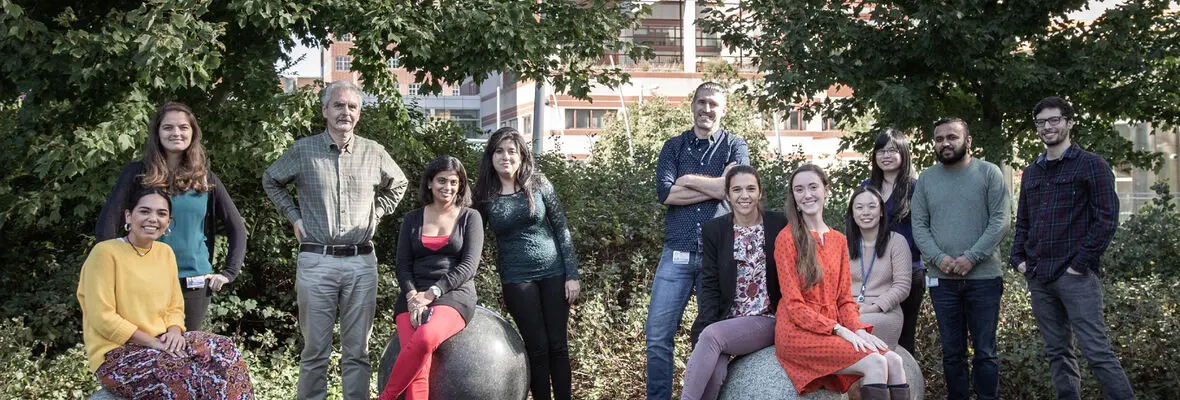Research
Since its inception in 1997, the Thomas-Tikhonenko laboratory has been broadly interested in the mechanisms of neoplastic transformation by the Myc family oncoproteins (including c- and N-Myc). The corresponding genes are altered via chromosomal translocation in B-cell lymphomas and are amplified or otherwise deregulated in many solid malignancies in adults and children alike. Yet their exact roles in promoting neoplastic growth in genetically complex human cancers remained only partially understood.
The major breakthrough in the field was the discovery of MYC-regulated microRNAs, in particular the miR-17~92 cluster, which is transcriptionally induced by Myc family members. Early on, we were able to demonstrate that in solid tumors, such as pediatric neuroblastoma and colon adenocarcinoma, deregulation of miR-17-92 leads to profound suppression of TGFβ signaling and sharply diminished production of many anti-angiogenic factors such as thrombospondin-1 and clusterin (Chayka et al, J Natl Cancer Inst 2009; Dews et al, Cancer Res 2010; Mestdagh et al, Mol Cell 2010, Sundaram et al, Cancer Res 2011, Fox et al, RNA 2013, Dews et al, J Natl Cancer Inst 2014). This brings about robust tumor neovascularization and enhanced neoplastic growth. In fact, our ‘06 discovery that miR-17~92 augments tumor angiogenesis (Dews et al, Nature Genet 2006) was the first example of the involvement of microRNAs in non-cell-autonomous tumor phenotypes and vascular biology. Subsequent studies also demonstrated that miR-17~92 participates in a cross-talk between TGFβ and WNT pathways, forming oncogenic feed-forward loops (Lanauze et al, Mol Cancer Res 2021; Sehgal et al, Mol Cancer Res 2021).
To determine the contribution of Myc to malignant growth in hematopoietic tissues, we developed several mouse models for B-cell lymphoma based on infection of p53-deficient bone marrow progenitors by Myc-encoding retroviruses (Yu et al, Blood 2007; Cozma et al, J Clin Invest 2007; Amaravadi et al, J Clin Invest 2007). Unexpectedly, we discovered that the salient feature of Myc-induced lymphomagenesis was not only overexpression of the oncogenic miR-17-92 but also repression of several tumor suppressive microRNAs, such as miR-15/16 and miR-34 (Chang et al, Nature Genet 2008; Chang et al, Proc Natl Acad Sci 2009, Sotillo et al, Oncogene 2011). These microRNAs affect c-Myc expression levels and contribute to deregulation of multiple Myc target genes involved in therapeutic apoptosis and chemoresistance (Harrington et al, Leukemia 2019; Harrington et al, Trends Cancer 2021) and last but not least - B-cell receptor signaling. The role of BCR and its co-receptor CD19 in promoting lymphomagenesis was the focus of the two key papers published in early ‘10s (Chung et al, J Clin Invest 2012; Psathas et al, Blood 2013).
As CD19 became recognized as the major target for immunotherapy in general and chimeric antigen receptor-armed autologous T cells (CARTs) in particular, we dedicated major effort towards elucidating the mechanism of epitope loss in post-CART19 relapses of acute lymphoblastic leukemia. This work was aided by our participation in the multi-institutional St. Baldrick's-Stand Up to Cancer Pediatric Cancer Dream Team (2013-present; 2021 AACR Team Science Award). Using whole exome and RNA sequencing, we identified two alternatively spliced CD19 mRNA species: one lacking exons 5 and 6 (Δex5-6), which encode the transmembrane domain, and another lacking exon 2 (Δex2). We further showed that skipping of exon 2 compromised surface localization of CD19 and yielded truncated CD19 protein variants, which fail to trigger killing by CART-19 (Sotillo et al, Cancer Discovery 2015; Bagashev et al, Mol Cell Biol 2018; Black et al, Nucl Acids Res 2018). Subsequent work identified additional aberrant splicing events (e.g., CD19 intron 2 retention) as major drivers of resistant to CD19-directed immunotherapy (Asnani et al, Leukemia 2020; Cortés-López et al, Nat Commun 2022) as well as similar splicing-based mechanisms of epitope loss affecting other targets (Zheng et al, Blood Cancer Discov 2022; Cai et al, Nat Commun 2022; Ang et al, Blood 2023).
Since 2018, the Thomas-Tikhonenko lab has been an integral part of the Pediatric Immunotherapy Discovery and Development Network (PI-DDN) funded through Beau Biden Cancer Moonshot Initiative. Our most recent work informed the central hypothesis that non-canonical exon usage plays a dual role in leukemia and other pediatric cancers. On the one hand, it provides cancers with intrinsic mechanisms of epitope loss, which can render targeted immunotherapy ineffective. On the other hand, alternative splicing could be a source of cancer-specific epitopes and as such could aid immunotherapy. By simultaneously exploring the effects of alternative splicing on antigen loss and neo-epitope gain, we aspire to lay ground for the development of new immunotherapeutics that would target pediatric cancers with the specificity current modalities do not possess.





